
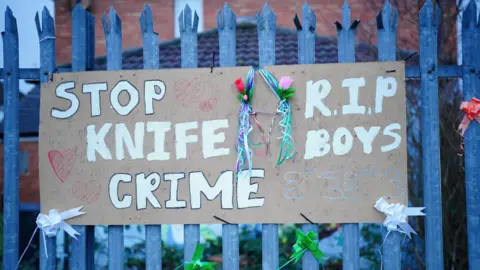 PA Media
PA Media
Bristol has been shocked by a recent rise in knife crime, which has claimed the lives of numerous teenagers and sent many others to prison. The BBC joined a team trying to protect young people by getting weapons off the streets.
“That’s the car, the grey one,” says an undercover officer, pointing to a battered Seat speeding down one of Bristol’s terraced streets.
Pursued by sirens and blue lights, the young driver makes a critical error – turning into a dead end. There’s a panicked turn, parked cars are rammed.
Officers spring from a patrol car and pull out their batons. The mid-morning peace is shattered by car windows being smashed and orders being yelled.
“Stay where you are! Put your hands where we can see them!”
“Weapons found,” shouts one of the officers, lifting a large curving zombie knife with a bright blue edge – and that’s not all.
PC Christina Jones holds up a machete, found under the seats.
“No-one’s out with balaclavas and zombie knives with good intentions,” she says. “There’s every likelihood some kind of conflict was going to arise from this.”
Inside the car, there are four young men aged between 16 and 18, and in the middle seat, a 17-year-old girl. They are all handcuffed – quivering with adrenaline and shaking broken glass from their hoodies.
This is Operation Remedy – an initiative set up to disrupt the wave of teenage violence across the city.

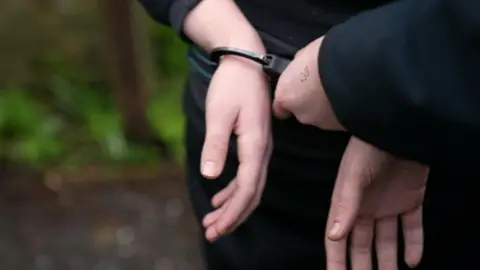
“So young” read the front page headline of the Bristol Post alongside the beaming faces of Mason Rist, 15 and Max Dixon, 16, who were fatally stabbed at the end of January.
Less than three weeks later, Darrian Williams bled to death outside a shop. The 16-year-old had been stabbed in the back in a park and staggered to the road for help.
“Bristol and its surrounding areas are in the middle of a plague of knife crime,” declared Mr Justice Saini at the city’s Crown Court, as he jailed three 16-year-olds found guilty of killing Mikey Roynon.
He was stabbed in the neck at a house party last summer – another life lost at 16.
“We have a lot of teenagers carrying knives – in their minds they think everyone else is carrying them,” says PC Jones. “Anything can happen – it can be a split-second decision to use those knives with lethal consequences, and we’ve seen that multiple times this year already, where people have lost their lives.”
Others have been seriously wounded – a 16-year-old narrowly survived a stabbing in a city centre McDonald’s.
Many of those suspected, charged, or convicted of these crimes are around the same age.
“It’s getting a bit out of control,” PC Jones says. “We’re talking about disembowelment, life changing injuries, amputations, significant brain injuries.”
It’s not just the police responding. At City Hall, there are monthly meetings bringing together education, health, community work, council services and law enforcement.
In the room are teachers who’ve lost pupils, social workers supporting bereaved and broken families, and medics who’ve stitched children’s wounds or had to declare them dead.

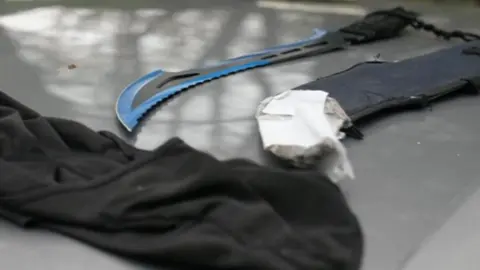
Giles Haythornthwaite, a trauma doctor from Bristol Royal Hospital for Children, is clear about the threat level they have faced.
“There was a real worry that things were going to kick off in a big style between the gangs,” he says. “There’s no complacency – because it could happen tonight. We know we’ve still got that risk, but we want to push the prevention further so we don’t get to the point of crisis.”
For City Council leader Tony Dyer it’s about shared responsibility.
“There’s no one single organisation capable of solving that problem,” he says. “If we are going to protect our young people it’s going to be by all of us working together and producing a collaborative effort.”
This is a renewed effort on a bigger scale – sharing insights, intelligence and advice to spot the signs of young people slipping towards violence. They talk of vulnerable teenagers being “groomed” into crime in the same way that young people are sexually exploited.
It’s something Julia Grey, principal at City of Bristol College, is alert to.
“It may look glamorous and it may look enticing, but a life in the criminal world is a horrific life,” she says, “so we need to provide options for our young people to live legitimate lives.”
Operation Remedy is a sensitive initiative, balancing the concern of residents who have witnessed bloodshed against complaints of disproportionate policing. There’s pushback – a plan to install temporary metal detecting knife arches in the city centre has been repeatedly delayed.
Some businesses don’t like the image, some communities feel unfairly targeted. Stop and search has long been controversial, and the police are wary of accusations of discrimination and heavy-handed tactics.
Officers are discouraged from referring to “gangs” when describing violent groups because of concerns it infers they’re predominantly from black or ethnic minority backgrounds. The reality of Bristol’s youth violence is multi-ethnic.

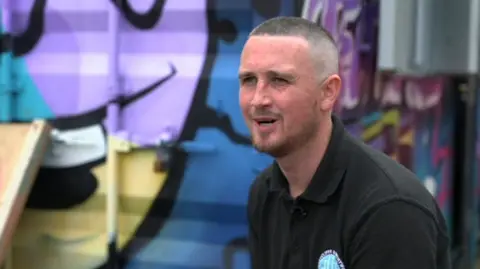
Avon and Somerset Police is clear the growing problem is among young men aged 14 to 19, but some boys are picking up weapons much younger.
“There are six or seven-year-olds carrying knives,” says Zac Dugdale, a youth worker handing out bike helmets to a group of lads taking to the BMX track.
“I think fear is the main factor why they’re carrying a knife. When you think of a seven or eight-year-old, you think of a young person who’s got innocence, and at the moment we’re seeing young people losing that innocence from such a young age.”
Zac’s organisation, Hartcliffe and Withywood Community Partnership, also runs “Talkback and Sides”, offering free haircuts with a frank conversation.
“I just don’t feel safe outside,” says a nine-year-old in the barber’s chair. “I feel more safe inside my house, not outside. Here, I can have a nice time without any worries of anything bad happening.”
Even experienced officers seem daunted.
“This last few months I’ve seen more stabbings and murders than I’ve ever known,” says PC Jones. “I’ve got children that sort of age, it does make me concerned for that generation.”
She’s on the lookout for a 10-year-old boy – reportedly with a knife – exposing himself to women and committing indecent assaults. He was eventually arrested and has been released, still under investigation.

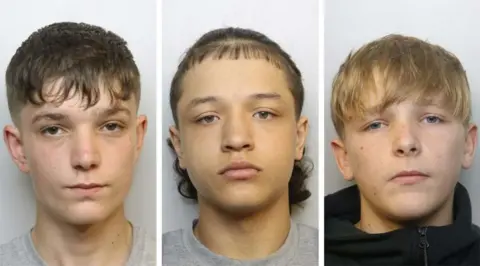 Avon and Somerset Police
Avon and Somerset Police
And that’s the other fine balance here – engagement or enforcement, intervention or incarceration? The intent is to avoid criminalising under-18s whenever possible.
“Putting a child in prison is not the answer,” says Detective Chief Inspector Larisa Hunt, who heads up Avon and Somerset Police’s early intervention team. “It’s not the solution because they’ll come out of prison, so what then?”
BBC News was given access to a weekly meeting monitoring young people at greatest risk of violence, either as perpetrator or victim – and often the same person risks both.
Updates are shared, incidents raised, movements tracked, and action plans agreed. They discuss a pair of teenagers who stole a car last night after threatening the occupants with a machete and a gun.
There’s urgency to understand how they’re linked – to the victims, to each other and to the rest of the faces on their wall of young people to worry about. One of the names is familiar and will be shared with the council youth team.
Another young man has been threatened and stamped on over a perceived debt. He won’t say by who, but the team must still consider how to stop retaliatory attacks that could quickly escalate.
These are officers who really know the lives of these young people and their families – it’s a task somewhere between surveillance and social work, but trust is fragile.
One lad has stopped replying to messages. He’s known to be staying with relatives out of the area, but there’s a fear he’ll return and fall back into criminal associations and violent confrontation. An officer is assigned to talk to his mum and agree a plan with his social worker.
Every case is discussed in detail with care, understanding and concern. The juveniles on their watchlist are treated as vulnerable children, likely facing exploitation by older criminals and forced to run drugs or hold weapons.

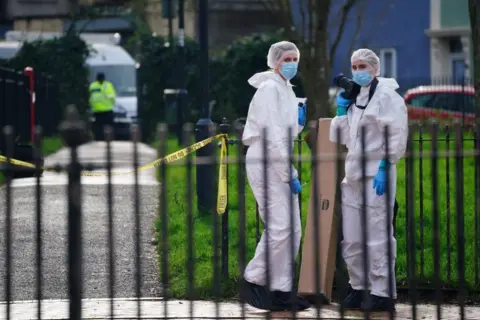 PA Media
PA Media
In the cul-de-sac where the car chase ended, the five teenagers don’t have much to say. I asked a bearded, weighty 16-year-old why he was carrying such a dangerous weapon in a residential street on a Wednesday morning.
“I don’t know,” he says, gruffly. “So I’m not the odd one out, maybe?” He says he didn’t intend to use it to harm anyone: “I’m into knives, innit? I like the way they look.”
He was arrested for possessing a knife – as was the 18-year-old driver who was also accused of driving without a licence or insurance, and failing to stop. They’re both awaiting a decision on charges. The three from the back seat were released.
PC Christina Jones explains it may be difficult to prove possession of the machete and the zombie knife found beneath the car seats, if they all deny the offence.
- If you feel you are in danger or are worried about a friend getting caught up in violence, you can call Childline on 0800 1111
- If you feel it is an emergency, call the police immediately on 999
It’s hard to marry the brutal nature of the weapons and the shocking injuries they can inflict with the gawky young men shifting nervously on the pavement.
Removing their balaclavas has taken away any intimidating edge. These are not hardened gangsters. They try to be cocky in front of the officers, but they aren’t convincing.
They are children, wide-eyed and worried. But still, they were armed and capable of something very dangerous.
“Some of things they are doing to each other are horrific,” PC Jones says. “They don’t seem to put the same value on human life. Maybe it’s self-value, or their value for each other.
“I feel like we have a lot to do. We are having success, but we need to do more, and not just policing.”
Additional reporting by Alex Littlewood








